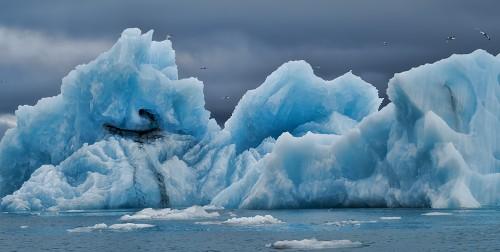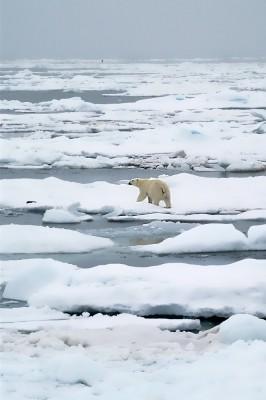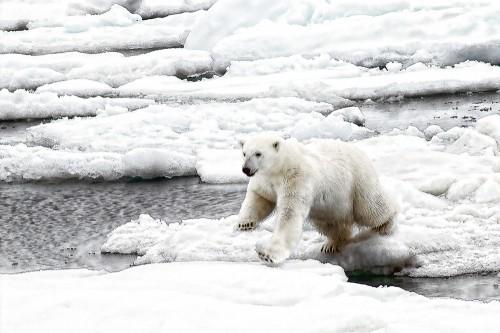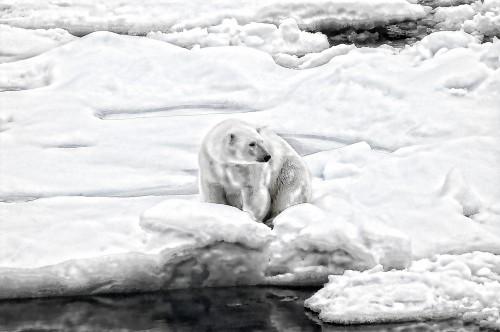I remember the precise moment at which I became a photographer. For years before that, I was someone who occasionally took pictures. And just before that, I entombed my old Pentax film camera in a closet and bought a digital camera. The new DSLR wasn’t a particularly good one, and the kit lens that came with it was slow and soft. I could have spent more money on better equipment, but I didn’t want to. At the time my relationship with photography was ambivalent—although I loved strong, emotional images of wildlife and the natural world, I worried that experiencing nature though a viewfinder limits and distorts what one might otherwise see. I feared that taking pictures subverts experience, that it becomes the experience.
I bought the new camera in 2005, shortly before leaving on a trip with my husband to Svalbard, an archipelago located halfway between the Norwegian mainland and the north pole. Our primary goal was to see polar bears. On a ship called the Endeavor, we would circumnavigate the island of Spitsbergen, hoping to reach its eastern side. Far from waters warmed by the North Atlantic current, the eastern shores were awash with pack ice, which made Svalbard polar bear heaven.

Our ship’s full name was the National Geographic Endeavour, and our expedition was sponsored by the National Geographic Society, which likes to refer to any plain old trip as an expedition. I suppose this is meant to enhance the sense of adventure amongst those on board. In actuality, eating four meals a day on a ship stocked with guides, naturalists, chambermaids, and a full bar bore little resemblance to my idea of an expedition. This was not a trip that would require anyone to bivouac on a narrow ledge of rock for three days in a snowstorm, or make a tough decision about whether it was time to consume the camels. This was, let’s face it, a luxury cruise.
Although we encountered an array of Arctic wildlife, polar bears were the highlight, and one was particularly memorable. On first sighting our ship, she stood for a better look. She was six feet tall from the crown of her white-furred head to the black pads of her feet, and she weighed about 500 pounds. That seemed big, until she charged the ship, which was 10,000 times her size using tonnage as a scale, 50 times bigger by length. Either way, that was one confident bear.
When she reached the ship’s massive bow and it failed to turn tail and run, she stopped to consider the situation. I think she was flummoxed by the ship’s composure. And understandably so—she belonged to a tiny elite, a group of animals so high up the food chain that they have no predators themselves—an apex predator. They instill fear; they do not themselves feel it. A ringed seal would have made an expeditious exit, diving through the nearest breathing hole in the ice. Expecting the ship to flee, the bear was perplexed by its immobility. She sniffed at the hull, then seemed to shrug, as if thinking, “Huh…go figure.” Turning away, she meandered away across the ice, jumping gracefully from floe to floe when gaps of water necessitated the effort. She receded gradually into a yellowish-white speck, and disappeared into miles of white ice.

When the bear charged our ship, I was already on deck, camera in hand. This readiness was a peculiarity of traveling on the Endeavour, where natural experiences, it turns out, were announced over an intercom. “Ladies and gentlemen,” a voice would intone on the ship’s public address system, while we were eating breakfast or reading in our cabins, “please excuse the interruption, but the Captain has just spotted a polar bear on the starboard side of the ship.” And all 96 passengers would grab their hats and down jackets and bolt starboard to see the bear.
It seemed like cheating. I am used to long, often disappointing waits for nature to happen. In Africa, one might spend an entire day at a water hole, waiting to see what animals will come. Or one might drive for hours, listening for alarm calls, looking for lechwe on full alert, their bodies aligned like fence posts, all eyes oriented in one direction. These are signs that nature is about to erupt: a cheetah at full throttle, lions crouched low in the bush. This hard work, the patient searching, watching and waiting, makes me feel entitled to the reward of seeing wildlife.
For a photographer, when at last animals do appear, their simple presence is not enough. If one’s goals are artistic, the camera must record something singular, some magical convergence of light and behavior or concept and technique, something to set this photo apart from thousands of pictures taken already of polar bears, leopards, howler monkeys, and all the creatures that populate the planet. It’s one thing to take a picture that brings home a memory. It’s quite another to make a remarkable image.
Robert Heinecken, an artist who pushed hard at the edges of photography but seldom used a camera himself, said, “Many pictures turn out to be limp translations of the known world instead of vital objects which create an intrinsic world of their own. There is a vast difference between taking a picture and making a photograph.” And, no matter how much we might want to achieve the latter, making a good photograph is not easy. The master of the landscape, Ansel Adams, wrote, “Twelve significant photographs in any one year is a good crop.”
My memories of photographing that polar bear are rooted in physical sensation. Although my camera wasn’t heavy, my biceps ached from trying to hold it steady against my eye. As the bear walked the ice on the ship’s port side, I could no longer feel my right index finger, the one that depresses the camera shutter. My fingers were numb with cold, and I shook my hand periodically to restore circulation. By then, nearly everyone had retreated to warm cabins, but a few of us remained with cameras focused on the bear. Braced against the rail of the port bow, we tried to time our shots to catch her in mid-air as she jumped from ice floe to ice floe. When she ambled across stretches of solid ice, we relaxed and warmed our fingers with our breath. As she reached the boundary of ice and water, we lifted our cameras, eyes glued to viewfinders, and waited. At the edge of the ice, the bear strode left then right, searching for the narrowest gap to the next sheet of ice. She chose her spot, raised her head, gauged the distance, then rocked her weight rearward, generating the momentum in her hindquarters to propel the leap.

As I watched her through the camera, anticipating the moment of her launch, I had an epiphany. I understood at that moment that I am never more deeply engaged with nature as I am when taking pictures. I was entirely focused, completely present, attuned to subtle changes in the bear’s posture that would time my shot to catch her leap. And doing that is harder than it sounds—the jump takes less than a second. I missed many pictures, as did my comrades, who swore when their shutters opened too late, or not at all. We were immersed in this bear, absorbed in her every movement. And I realized that I have never been so happy as during those twenty minutes—or was it two hours?—photographing the bear. She showed me that I am, in my heart, then and still, a photographer.
One of the guys on the bow was the real deal, a National Geographic photographer. He was a holdover from the ship’s previous cruise, a photographic expedition on which he was a featured attraction. Despite this stature, he liked to stay busy. If we dropped anchor for a hike, he grabbed a rifle and did double duty as a guide. He took pictures at every opportunity, and he stood next to me on the deck as we photographed the polar bear.
The wet sea air kept coating my lens with drops of water, and the microfiber cloth I was using to clean that glass was soggy and useless. Every swipe just rearranged the problem, changing droplets into smears. Seeing my situation, the National Geographic photographer dug into his pocket and proffered a wad of cloth. “Here,” he said, “use this. It’s dry.” It was a pair of checkered men’s boxer shorts. I blushed redder than I have since age fourteen. He said, “Don’t worry—they’re clean.” Preserving my dignity, I stuck with my wet lens cloth.

Later, weeks after returning from Svalbard, I worked up the courage to send him some photos. He was kind, even more so in retrospect when I look back at those pictures. As photographs, they were barely passable—I had so much to learn. Yet my new-found mentor encouraged me. He taught me things I ought already to have known, like the rule of thirds and classical guidelines for composition. He said I needed a tripod. He urged me to sell my still-new camera and invest in better equipment. “The best way to buy expensive camera gear,” he wrote, “is to take $20,000 and tell yourself that you are going to spend it all. That way it is painless.” He was right, and it was worth it. I enrolled in workshops and learned the essentials of wildlife photography. He urged me to buy books, trawl websites, and study great photos: “Think Nick Nichols for flash work and edginess, Frans Lanting for flash work and mood, Mitsuaki Iwago for behavior, Michio Hoshino for sense of place and great light.”
I did those things, and I took pictures—thousands of them—and showed a small number to people whose opinions I value. Sometimes they scolded me, telling me not to send them vacation pictures. They reminded me that photography is serious work, not fun. “Tell a story and effect positive change,” wrote the National Geographic photographer. “That is the obligation of every serious shooter. Shooting amazing images is part of it.” He urged me to be edgier, more creative, looser, tighter, more resourceful, less traditional, more dedicated. And every once in a while, once in a very blue moon, I’d send him a picture, and he’d say, “Yep. Good work.”
Twelve good photos a year. Now, years later, I’m maybe up to two or three.

Bruce Finocchio
16 Jun 2014For me too, nature photography makes the moments more powerful, more alive, as you intently observe a bird or animal for that special moment that they will show and share with you. You are just more in these moments, seeing more, feeling more, everything is more intense. You are totally absorb in the animal or bird, watching its behavior, its life; so you can capture a moving elemental story that shines as a work of art.
There is also a communication between you and the wildlife, non-verbal, spiritual–a humbleness that you feel as this bird or animal lets you into its life. You feel privileged and honored to witness a wild moment in a wild creature’s life. More than an observer of life, you become an active part of the web of life itself; a harmony with all things, and calm balance within yourself. When your eyes are seeing the world through a camera and lens.
Maybe it’s the closeness, maybe it’s the wonders you see clearly, maybe it’s the excitement you feel as miracles unfold before your eyes, nevertheless it’s there, and it’s true.
You treasure these moments forever; they live permanently on the viewing screen of your mind.
If this not an inspired passion and thrilling life, then, I don’t know what is.